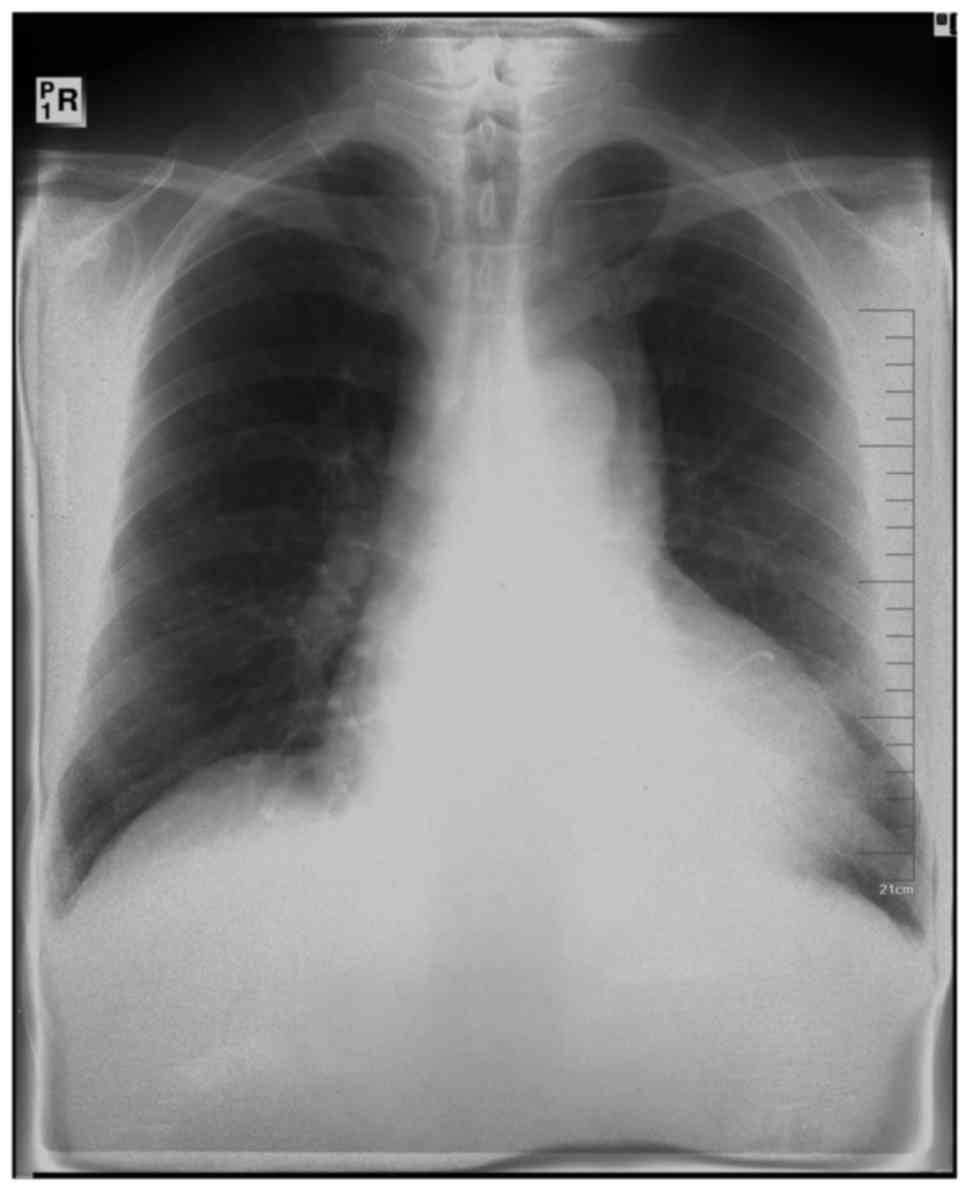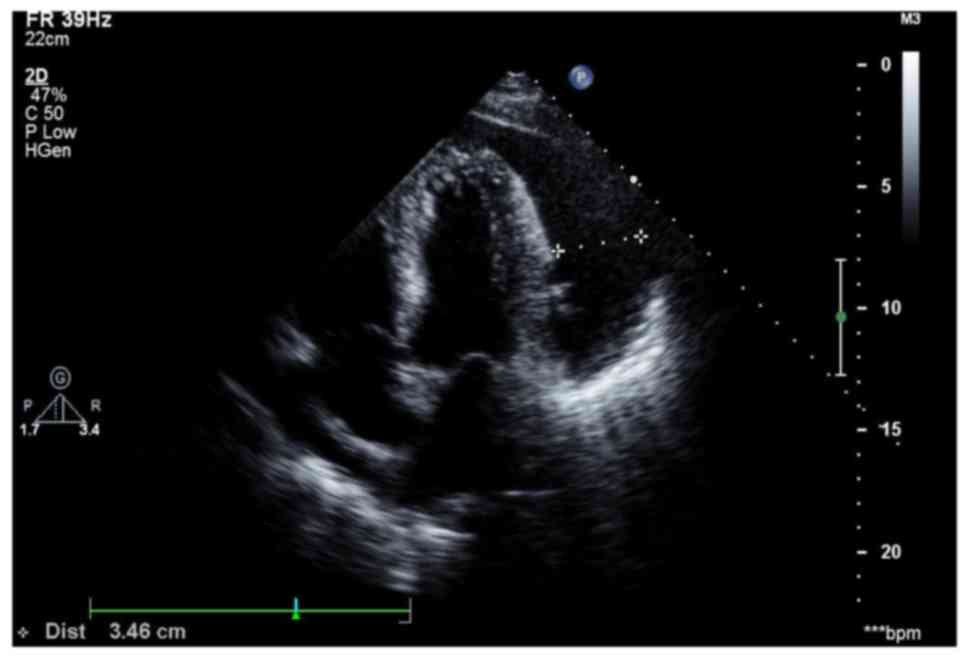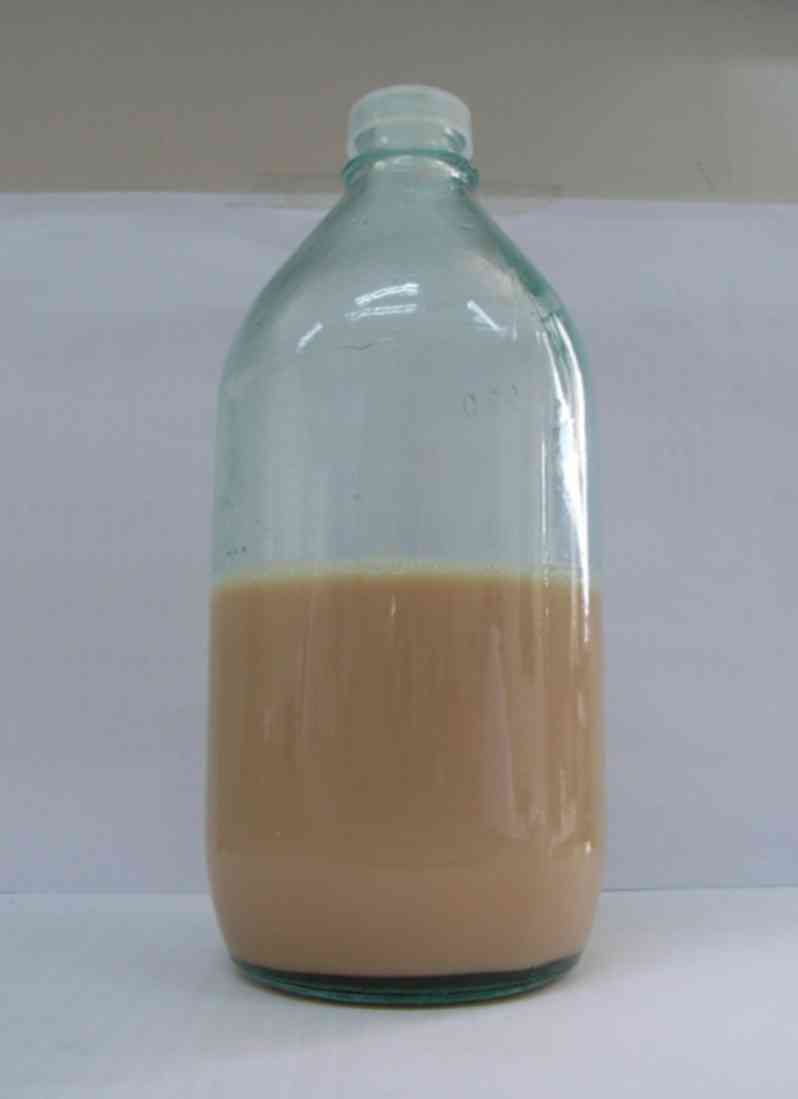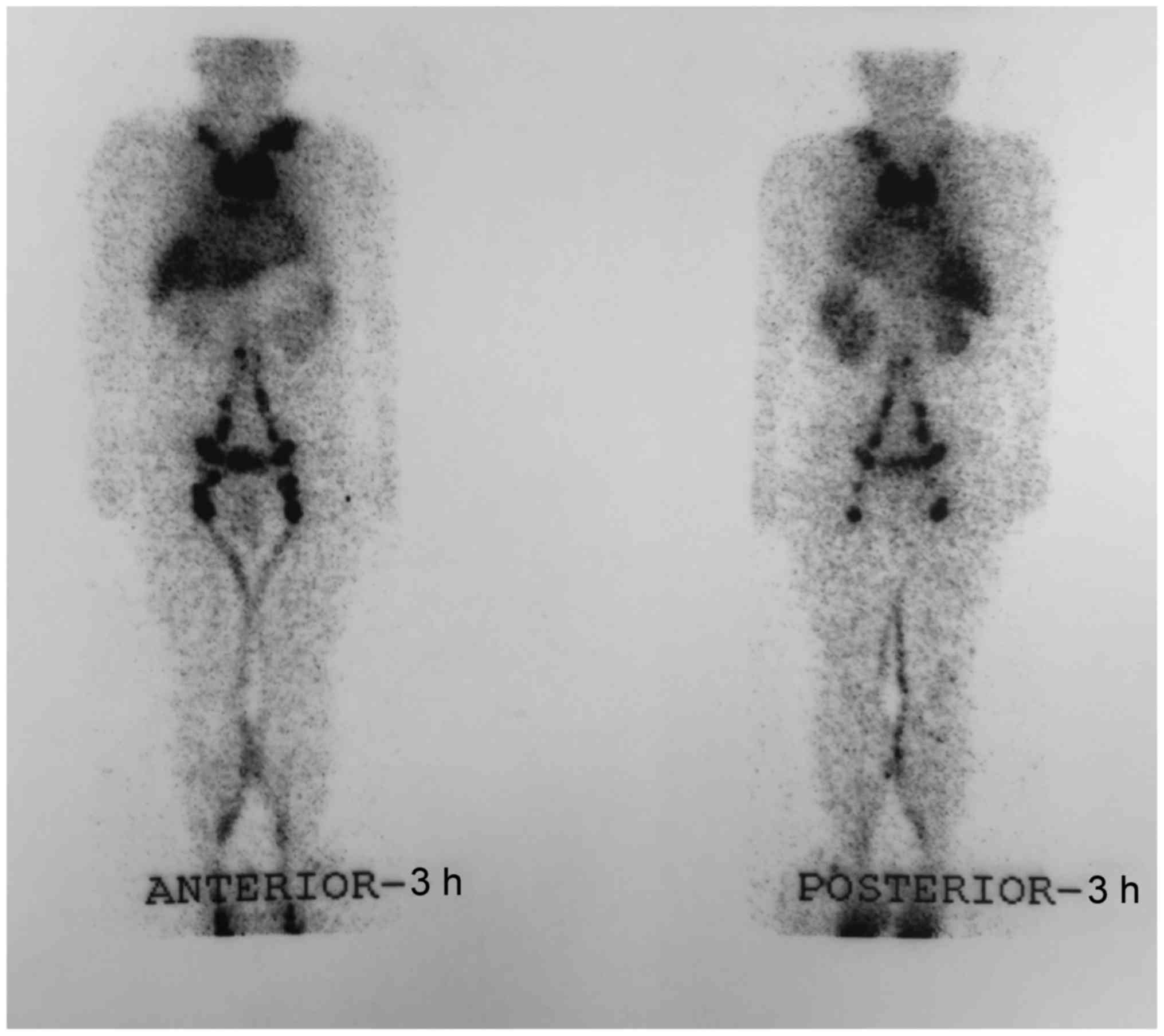Primary chylopericardium: A case report and literature review
- Authors:
- Xue Yu
- Na Jia
- Sanxia Ye
- Min Zhou
- Deping Liu
-
Affiliations: Department of Cardiology, Beijing Hospital, National Center of Gerontology, Beijing 100730, P.R. China, Department of Internal Medicine, Beijing Shijitan Hospital, Beijing 100038, P.R. China, Department of Cardiology, The First People's Hospital of Changzhou, Changzhou, Jiangsu 213003, P.R. China - Published online on: October 27, 2017 https://doi.org/10.3892/etm.2017.5383
- Pages: 419-425
This article is mentioned in:
Abstract
 |
 |
 |
 |
|
Hasebroek K: Analyse einer chylösen pericardialen Flüssigkeit (Chylopericardium). Biol Chem. 12:289–294. 1888.(In German). | |
|
Groves LK and Effler DB: Primary chylopericardium. N Engl J Med. 250:520–523. 1954. View Article : Google Scholar : PubMed/NCBI | |
|
Raza M and Matar K: Idiopathic chylothorax and chylopericardium resistant to conservative and surgical management. Heart Lung Circ. 18:229–232. 2009. View Article : Google Scholar : PubMed/NCBI | |
|
Courtney M and Ayyagari RR: Idiopathic chylopericardium treated by percutaneous thoracic duct embolization after failed surgical thoracic duct ligation. Pediatr Radiol. 45:927–930. 2015. View Article : Google Scholar : PubMed/NCBI | |
|
Ossiani MH, McCauley RG and Patel HT: Primary idiopathic chylopericardium. Pediatr Radiol. 33:357–359. 2003. View Article : Google Scholar : PubMed/NCBI | |
|
Dib C, Tajik AJ, Park S, Kheir ME, Khandieria B and Mookadam F: Chylopericardium in adults: A literature review over the past decade (1996–2006). J Thorac Cardiovasc Surg. 136:650–656. 2008. View Article : Google Scholar : PubMed/NCBI | |
|
Faul JL, Berry GJ, Colby TV, Ruoss SJ, Walter MB, Rosen GD and Raffin TA: Thoracic lymphangiomas, lymphangiectasis, lymphangiomatosis, and lymphatic dysplasia syndrome. Am J Respir Crit Care Med. 161:1037–1046. 2000. View Article : Google Scholar : PubMed/NCBI | |
|
Rostom AY: Treatment of thoracic lymphangiomatosis. Arch Dis Child. 83:138–139. 2000. View Article : Google Scholar : PubMed/NCBI | |
|
Luisada AA: Development and structure of the cardiovascular system. Am Heart J. 64:4351962. View Article : Google Scholar | |
|
Chen E and Itkin M: Thoracic duct embolization for chylous leaks. Semin Intervent Radiol. 28:63–74. 2011. View Article : Google Scholar : PubMed/NCBI | |
|
Dunn RP: Primary chylopericardium: A review of the literature and an illustrated case. Am Heart J. 89:369–377. 1975. View Article : Google Scholar : PubMed/NCBI | |
|
Naef AP: Primary chylopericardium and its surgical treatment. Dis Chest. 30:160–167. 1956. View Article : Google Scholar : PubMed/NCBI | |
|
Svedjeholm R, Jansson K and Olin C: Primary idiopathic chylopericardium-a case report and review of the literature. Eur J Cardiothorac Surg. 11:387–390. 1997. View Article : Google Scholar : PubMed/NCBI | |
|
Harada K, Takigawa I, Toyoda H, Okada T and Usami H: Primary chylopericardium recovered without surgical treatment. Report of a case and review of the literature. Jpn Circ J. 46:162–171. 1982. View Article : Google Scholar : PubMed/NCBI | |
|
Akamatsu H, Amano J, Sakamoto T and Suzuki A: Primary chylopericardium. Ann Thorac Surg. 58:262–266. 1994. View Article : Google Scholar : PubMed/NCBI | |
|
Han Z, Li S, Jing H and Liu H: Primary idiopathic chylopericardium: A retrospective case series. BMC Surg. 15:612015. View Article : Google Scholar : PubMed/NCBI | |
|
Yankopoulos NA, Akbarian M, Starkey GW and Abelmann WH: Isolated chylopericardium. Diagnosis, hemodynamic studies and surgical treatment. Am J Cardiol. 19:440–446. 1967. View Article : Google Scholar : PubMed/NCBI | |
|
Fawal IA, Kirkland L, Dykes R and Foster GL: Chronic primary chylopericardium. Report of a case and review of the literature. Circulation. 35:777–782. 1967. View Article : Google Scholar : PubMed/NCBI | |
|
Puig-Massana M, Murtra M and Calbet JM: Idiopathic massive chylopericardium. Br Heart J. 34:431–433. 1972. View Article : Google Scholar : PubMed/NCBI | |
|
Chavez CM, Rodriquez GR and Conn JH: Isolated chylopericardium. Lymphographic findings and surgical treatment. Am J Cardiol. 32:352–355. 1973. View Article : Google Scholar : PubMed/NCBI | |
|
Gallant TE, Hunziker RJ and Gibson TC: Primary chylopericardium: The role of lymphangiography. AJR Am J Roentgenol. 129:1043–1045. 1977. View Article : Google Scholar : PubMed/NCBI | |
|
Charnilas Y, Levo Y, Weiss A, Glaser J and Levy MJ: Isolated idiopathic chylopericardium. J Thorac Cardiovasc Surg. 73:719–721. 1977.PubMed/NCBI | |
|
Toltzis RJ, Rosenthal A, Fellows K, Castaneda AR and Nadas AS: Chylous reflux syndrome involving the pericardium and lung. Chest. 74:457–458. 1978. View Article : Google Scholar : PubMed/NCBI | |
|
de Haan HP, Kolff J and Buis B: Isolated chylopericardium due to lymphangiomatous dysplasia of the thymus. Eur Heart J. 5:846–849. 1984. View Article : Google Scholar : PubMed/NCBI | |
|
Mask WK, Penido JR and Printup C: Primary idiopathic chylopericardium. J Thorac Cardiovasc Surg. 99:569–571. 1990.PubMed/NCBI | |
|
Itoh T, Tanaka S, Nakanishi M, Nishiyama K, Kitajima N, Kinoshita Y, Inatome T, Inoh T and Fukuzaki H: Primary chylopericardium with pulmonary shadow and large granular lymphocytosis: A case report. Lymphology. 24:168–173. 1991.PubMed/NCBI | |
|
de Winter RJ, Bresser P, Romer JW, Kromhout JG and Reekers J: Idiopathic chylopericardium with bilateral pulmonary reflux of chyle. Am Heart J. 127:936–939. 1994. View Article : Google Scholar : PubMed/NCBI | |
|
Scholten C, Staudacher M, Girsch W, Wolf G, Grimm M, Binder T, Lang I and Stefenelli T: A novel therapeutic strategy for the management of idiopathic chylopericardium and chylothorax. Surgery. 123:369–370. 1998. View Article : Google Scholar : PubMed/NCBI | |
|
Mewis C, Kühlkamp V, Sokiranski R and Karsch KR: Primary chylopericardium due to partial aplasia of the thoracic duct. Eur Heart J. 18:880–881. 1997. View Article : Google Scholar : PubMed/NCBI | |
|
Baratella MC, Montesello M and Marinato P: Images in cardiology. Idiopathic chylopericardium. Heart. 80:3761998. View Article : Google Scholar : PubMed/NCBI | |
|
Wang CH, Yen TC, Ng KK, Lee CM, Hung MJ and Cherng WJ: Pedal (99m)Tc-sulfur colloid lymphoscintigraphy in primary isolated chylopericardium. Chest. 117:598–601. 2000. View Article : Google Scholar : PubMed/NCBI | |
|
Sakata S, Yoshida I, Otani Y, Ishikawa S and Morishita Y: Thoracoscopic treatment of primary chylopericardium. Ann Thorac Surg. 69:1581–1582. 2000. View Article : Google Scholar : PubMed/NCBI | |
|
Rizzello V, Colizzi C and Falappa P: Primary chylopericardium due to lymphangiectasias: The crucial role of lymphangiography. Eur Heart J. 29:19742008. View Article : Google Scholar : PubMed/NCBI | |
|
Cho BC, Kang SM, Lee SC, Moon JG, Lee DH and Lim SH: Primary idiopathic chylopericardium associated with cervicomediastinal cystic hygroma. Yonsei Med J. 46:439–444. 2005. View Article : Google Scholar : PubMed/NCBI | |
|
Mitsui K, Namiki K, Matsumoto H, Konno F, Yoshida R and Miura S: Thoracoscopic treatment for primary chylopericardium: Report of a case. Surg Today. 35:76–79. 2005. View Article : Google Scholar : PubMed/NCBI | |
|
Miyoshi K, Nakagawa T, Kokado Y, Matsuoka T, Kameyama K and Okumura N: Primary chylopericardium with pulmonary lymphedema. Thorac Cardiovasc Surg. 56:306–308. 2008. View Article : Google Scholar : PubMed/NCBI | |
|
Schild HH, Simon B, Kuhl CK, Nelles M, Koerfer R, Skowasch D, Kuntz-Hehner S and Haude M: Percutaneous treatment of idiopathic chylopericardium. J Vasc Interv Radiol. 20:842–846. 2009. View Article : Google Scholar : PubMed/NCBI | |
|
Itkin M, Swe NM, Shapiro SE and Shrager JB: Spontaneous chylopericardium: Delineation of the underlying anatomic pathology by CT lymphangiography. Ann Thorac Surg. 87:1595–1597. 2009. View Article : Google Scholar : PubMed/NCBI | |
|
Madison WM Jr and Logue B: Isolated (primary) chylopericardium due to anomalous communications with the thoracic duct, of unknown causation. Am J Med. 22:825–830. 1957. View Article : Google Scholar : PubMed/NCBI | |
|
Glasser SP, Cheitlin MD, Serfas LS and Sbar SS: Isolated massive chylopericardium. Am Heart J. 75:663–672. 1968. View Article : Google Scholar : PubMed/NCBI | |
|
Lee CY, Di Loreto PC and Kim S: Isolated primary chylopericardium in pregnancy. Obstet Gynecol. 43:586–591. 1974.PubMed/NCBI | |
|
Jenner R and Oo H: Isolated chylopericardium due to mediastinal lymphangiomatous hamartoma. Thorax. 30:113–117. 1975. View Article : Google Scholar : PubMed/NCBI | |
|
Savran SV, Ratshin RA, Shirley JH, Naguwa SM and Goodman L: Idiopathic chylopericardium: 131-I-triolein scan for noninvasive diagnosis. Ann Intern Med. 82:663–665. 1975. View Article : Google Scholar : PubMed/NCBI | |
|
Ross P, Joseph S and Walker D: A case of isolated primary chylopericardium. Br Heart J. 41:508–511. 1979. View Article : Google Scholar : PubMed/NCBI | |
|
Rankin RN, Raval B and Finley R: Primary chylopericardium: Combined lymphangiographic and CT diagnosis. J Comput Assist Tomogr. 4:869–870. 1980. View Article : Google Scholar : PubMed/NCBI | |
|
Torrington KG and Youkey JR: Simultaneous idiopathic chylopericardium and chylothorax. South Med J. 74:357–359. 1981. View Article : Google Scholar : PubMed/NCBI | |
|
Bewick DJ, Johnstone DE and Landrigan PL: Primary chylopericardium associated with allergic alveolitis. Can Med Assoc J. 130:1577–1579. 1984.PubMed/NCBI | |
|
Morishita Y, Taira A, Furoi A, Arima S and Tanaka H: Constrictive pericarditis secondary to primary chylopericardium. Am Heart J. 109:373–375. 1985. View Article : Google Scholar : PubMed/NCBI | |
|
Musemeche CA, Riveron FA, Backer CL, Zales VR and Idriss FS: Massive primary chylopericardium: A case report. J Pediatr Surg. 25:840–842. 1990. View Article : Google Scholar : PubMed/NCBI | |
|
Yoon YS, Shim WH, Chung TS and Lee YS: Primary idiopathic chylopericardium: Report of a case and review of the literature. Yonsei Med J. 34:98–108. 1993. View Article : Google Scholar : PubMed/NCBI | |
|
Chiu CH, Su WJ, Chang JP and Chang CH: Primary chylopericardium: Report of a case. J Formos Med Assoc. 92:468–471. 1993.PubMed/NCBI | |
|
Taggart SC, Roberts TE and Marshall DA: Chylopericardium complicating pericardiocentesis for acute idiopathic pericardial effusion. J Thorac Cardiovasc Surg. 108:388–389. 1994.PubMed/NCBI | |
|
Yang MF, Long MQ, Tian J and Li ZJ: A case of chylopericardium diagnosed by lymphoscintigraphy. Zhonghua Heyixue Zazhi. 14:157–158. 1994.(In Chinese). | |
|
Furrer M, Hopf M and Ris HB: Isolated primary chylopericardium: Treatment by thoracoscopic thoracic duct ligation and pericardial fenestration. J Thorac Cardiovasc Surg. 112:1120–1121. 1996. View Article : Google Scholar : PubMed/NCBI | |
|
Chinushi M, Watanabe Y, Aizawa Y, Hanawa H, Yamazoe M, Osman Y, Shibata A and Shinonaga M: Suppression of fluid accumulation following pericardial inflammation in a patient with primary chylopericardium. Jpn Heart J. 37:271–274. 1996. View Article : Google Scholar : PubMed/NCBI | |
|
Dogan R, Demircin M, Sarigül A, Celiker A, Güngen Y and Paşaoglu I: Isolated chylopericardium secondary to intrathymic lymphangiomatous malformation. Pediatr Cardiol. 17:413–415. 1996. View Article : Google Scholar : PubMed/NCBI | |
|
Yüksel M, Yildizeli B, Zonüzi F and Batirel HF: Isolated primary chylopericardium. Eur J Cardiothorac Surg. 12:319–321. 1997. View Article : Google Scholar : PubMed/NCBI | |
|
Akashi H, Tayama K, Ishihara K, Tanaka A, Fujino T, Okazaki T and Aoyagi S: Isolated primary chylopericardium. Jpn Circ J. 63:59–60. 1999. View Article : Google Scholar : PubMed/NCBI | |
|
López-Castilla JD, Soult JA, Falcón JM, Muñoz M, Santos J, Gavilan JL and Rodríguez A: Primary idiopathic chylopericardium in a 2 month old successfully treated without surgery. J Pediatr Surg. 35:646–648. 2000. View Article : Google Scholar : PubMed/NCBI | |
|
Bhat P, Ananthakrishna R, Panneerselvam A, Yalagudri SD, Rao PS and Nanjappa MC: Recurrent chylopericardium. BMJ Case Rep. 2011:pii: bcr07201145202011. View Article : Google Scholar | |
|
Sleilaty G, Rassi I, Alawi A and Jebara VA: Primary isolated chronic chylopericardium. Interact Cardiovasc Thorac Surg. 1:86–87. 2002. View Article : Google Scholar : PubMed/NCBI | |
|
Anil SR, Manoj P, Hejmadi A and Kumar RK: Massive primary chylopericardium in an infant. Indian Heart J. 54:295–296. 2002.PubMed/NCBI | |
|
Watanabe S, Kariatsumari K, Sakasegawa K, Imagama I, Yotsumoto G and Sakata R: Primary chylopericardium treated with video-assisted thoracoscopic surgery. Thorac Cardiovasc Surg. 50:360–361. 2002. View Article : Google Scholar : PubMed/NCBI | |
|
Mahon NG, Nölke L, McCann H, Sugrue D and Hurley J: Isolated chylopericardium. Surgeon. 1:236–238. 2003. View Article : Google Scholar : PubMed/NCBI | |
|
Fan SH, Ge MJ, Xiang XY and Wang B: Primary chylopericardium: A case report. Zhonguo Xiongxinxueguan Waike Linchuang Zachi. 17:3522010.(In Chinese). | |
|
Nanjo S, Yamazaki J, Tsubuku M, Ohyama T, Ohtsuka T and Nakano H: Primary idiopathic chylopericardium: Report of two cases. Ann Nucl Med. 18:537–539. 2004. View Article : Google Scholar : PubMed/NCBI | |
|
Yokusoglu M, Savasoz BS, Baysan O, Erinc K, Gunay C and Isik E: Primary chylopericardium. Thorac Cardiovasc Surg. 53:386–388. 2005. View Article : Google Scholar : PubMed/NCBI | |
|
Zisis C, Rontogianni D, Charalambous E and Bellenis I: Lymphangiomatous hamartoma: Cause or bystander of the isolated chylopericardium? J Thorac Cardiovasc Surg. 130:1201–1202. 2005. View Article : Google Scholar : PubMed/NCBI | |
|
Mehrotra S, Peeran NA and Bandyopadhyay A: Idiopathic chylopericardium: An unusual cause of cardiac tamponade. Tex Heart Inst J. 33:249–252. 2006.PubMed/NCBI | |
|
Cui FH, Xie MY and Huang JP: A primary chylopericardium misdiagnosed as tuberculous pericarditis. Zhongguo Wuzhenxue Zazhi. 9:1825–1826. 2006.(In Chinese). | |
|
Cervantes-Salazar JL, Calderón-Colmenero JE and Ramírez-Marroquín S: Idiopathic chylopericardium. A case in point. Rev Esp Cardiol. 60:884–885. 2007.(In Spanish). View Article : Google Scholar : PubMed/NCBI | |
|
Silva MA, Martins AS, Campos NL, Andrade RR, Tohi LM and Hueb JC: Primary idiopathic chylopericardium-case report. Arq Bras Cardiol. 92:e40–e43. e67–e70. 2009.(In English, Multiple languages). PubMed/NCBI | |
|
Timóteo AT, Albino JP, Branco LM, Banazol N, Colarinha P, Jalles NT and Ferreira R: Primary idiopathic chylopericardium. Rev Port Cardiol. 28:325–332. 2009.(In English, Portuguese). PubMed/NCBI | |
|
Barbetakis N, Asteriou C, Konstantinou D, Giannoglou D, Tsilikas C and Giannoglou G: Spontaneous chylous cardiac tamponade: A case report. J Cardiothorac Surg. 5:112010. View Article : Google Scholar : PubMed/NCBI | |
|
Luaces M, Perales I, Núñez-Gil IJ and Cabezudo J: Non-invasive diagnosis of chylopericardium by cardiac magnetic resonance imaging. Eur Heart J. 31:8232010. View Article : Google Scholar : PubMed/NCBI | |
|
Novitzky D and Guglin M: Chylopericardium presenting with tamponade and cardiogenic shock. J Card Surg. 25:522–524. 2010. View Article : Google Scholar : PubMed/NCBI | |
|
Tan JX, Fu Y and Chen J: Primary idiopathic chylopericardium: A case report. Cardiol Young. 23:773–775. 2013. View Article : Google Scholar : PubMed/NCBI | |
|
Mandarry MT, Ru XH, Wei ZQ and Ge MJ: Primary idiopathic chylopericardium: A rare case with a synopsis of the literature. Singapore Med J. 53:e156–e158. 2012.PubMed/NCBI | |
|
Gilmore D and Colson YL: Recurrent chylous pericardial effusion and left neck mass. Thorac Cardiovasc Surg. 60 Suppl 2:e25–e27. 2012. View Article : Google Scholar : PubMed/NCBI | |
|
Kwon JB, Choi SY, Kim CK and Park CB: Primary idiopathic silent chylopericardium. J Cardiothorac Surg. 8:282013. View Article : Google Scholar : PubMed/NCBI | |
|
Rivera-Beltrán S, Ortíz VN, Díaz R and Hernández JA: Transabdominal ligation of the thoracic duct with pericardial-peritoneal shunting in a case of primary idiopathic chylous pericardial effusion. J Pediatr Surg. 48:1434–1437. 2013. View Article : Google Scholar : PubMed/NCBI | |
|
Rosa GM and Campisi C, Bioccardo F, Dorighi U, Parodi A, Molinari L, Spinaci S, Dessalvi S, Brunelli C and Campisi C: Chylopericardium: A case report demonstrating utility of lymphography combined with 3D computed tomography for corrective surgical treatment using VATS. Lymphology. 47:40–43. 2014.PubMed/NCBI | |
|
Vinayakumar D, Arunkumar G, Sajeev CG, Rajesh G, Muneer K, Haridasan V, Babu K and Krishnan MN: Cystic lymphangioma of pericardium presenting as isolated chylopericardium-a case report. Indian Heart J. 66:119–121. 2014. View Article : Google Scholar : PubMed/NCBI | |
|
Karakurt C, Celik SF, Celik RM, Elkiran O, Ulutaş H and Kuzucu A: Primary idiopathic chylopericardium presenting with cardiac tamponade. Herz. 39:644–646. 2014. View Article : Google Scholar : PubMed/NCBI | |
|
Chew H, Shetty P, Elahi M and Akhunji Z: A case of spontaneous chylous pericardial effusion in Poland syndrome. Gen Thorac Cardiovasc Surg. 62:386–389. 2014. View Article : Google Scholar : PubMed/NCBI | |
|
Huang JW, Zhao D, Han F, Qi BL, Zhang SQ, Liu GT and Lin Y: A primary idiopathic chylopericardium. Zhongguo Yaowu Jingjixue. 10:255–256. 2014.(In Chinese). | |
|
Atkinson C and Banks K: Imaging idiopathic chylopericardium with 99mTc-SC lymphoscintigraphy and SPECT/CT. Clin Nucl Med. 40:e508–e510. 2015. View Article : Google Scholar : PubMed/NCBI | |
|
Fernandes F, Vieira GS, Arteaga E, Ianni BM, Pêgo- Fernandes P and Mady C: Cholesterol pericarditis. A specific but rare cause of pericardial disease. Arq Bras Cardiol. 76:391–394. 2001. View Article : Google Scholar : PubMed/NCBI | |
|
Alsemgeest F, Spiegelenberg SR and Kamp O: Cholesterol pericarditis with massive pericardial cholesterol cyst. Eur Heart J. 33:15542012. View Article : Google Scholar : PubMed/NCBI | |
|
Cilloniz C, Rangel E, Barlascini C, Piroddi IM, Torres A and Nicolini A: Streptococcus pneumoniae-associated pneumonia complicated by purulent pericarditis: Case series. J Bras Pneumol. 41:389–394. 2015.(In English, Portuguese). View Article : Google Scholar : PubMed/NCBI | |
|
Sagristà-Sauleda J, Barrabés JA, Permanyer-Miralda G and Soler-Soler J: Purulent pericarditis: Review of a 20-year experience in a general hospital. J Am Coll Cardiol. 22:1661–1665. 1993. View Article : Google Scholar : PubMed/NCBI | |
|
Liu DY, Shao Y and Shi JX: Unilateral pedal lymphangiography with non-contrast computerized tomography is valuable in the location and treatment decision of idiopathic chylothorax. J Cardiothorac Surg. 9:82014. View Article : Google Scholar : PubMed/NCBI | |
|
Chen FC, Huang JL, Lin WY and Ting CT: Pedal Tc-99m phytate lymphoscintigraphy in primary chylopericardium. Int J Cardiol. 90:341–343. 2003. View Article : Google Scholar : PubMed/NCBI | |
|
Sachs PB, Zelch MG, Rice TW, Geisinger MA, Risius B and Lammert GK: Diagnosis and localization of laceration of the thoracic duct: Usefulness of lymphangiography and CT. AJR Am J Roentgenol. 157:703–705. 1991. View Article : Google Scholar : PubMed/NCBI | |
|
Pitol R, Pederiva JR, Pasin F and Vitola D: Isolated chylopericardium after cardiac surgery. Arq Bras Cardiol. 82:384–389. 2004.(In English, Portuguese). View Article : Google Scholar : PubMed/NCBI | |
|
Denfield SW, Rodriguez A, Miller-Hance WC, Stein F, Ott DA, Jefferson LS and Bricker JT: Management of postoperative chylopericardium in childhood. Am J Cardiol. 63:1416–1418. 1989. View Article : Google Scholar : PubMed/NCBI | |
|
Selle JG, Snyder WH III and Schreiber JT: Chylothorax: Indications for surgery. Ann Surg. 177:245–249. 1973. View Article : Google Scholar : PubMed/NCBI | |
|
Melduni RM, Oh JK, Bunch TJ, Sinak LJ and Gloviczki P: Reconstruction of occluded thoracic duct for treatment of chylopericardium: A novel surgical therapy. J Vasc Surg. 48:1600–1602. 2008. View Article : Google Scholar : PubMed/NCBI |









